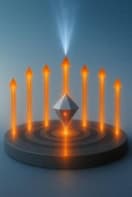
What does a dark-matter experiment buried deep under a mountain in Italy have in common with an airborne system that prospects for minerals in the Australian outback? The answer is that they both use SQUIDs (superconducting quantum interference devices) made by Star Cryoelectronics of Santa Fe, New Mexico.
The company makes a range of magnetic SQUID sensors that are based on both low- and high-temperature superconductors, as well as electronic control systems for these devices. The firm was founded in 1999 by the physicist Robin Cantor, who had previously been manager of the SQUID technology group at the firm’s predecessor Conductus (now part of Superconductor Technologies) in Sunnyvale California and who also worked on developing superconductor sensor technologies at the Los Alamos National Laboratory in New Mexico.
The company started by taking over the manufacturing of SQUIDs from Conductus. Since then Star Cryoelectronics has expanded its customer base and now supplies SQUIDs for a wide range of applications, including biomedical imaging, non-destructive materials testing, geophysical exploration and basic research.
While up to now the company has focused on supplying components and systems that are integrated into instruments made by other firms, it is poised to launch its first instrument: a SQUID-based X-ray spectrometer for use with electron microscopes that offers an energy resolution that is 10 times better than that of conventional silicon X-ray detectors.
Tunnelling current
A SQUID consists of a circuit of superconducting material that includes one or two Josephson junctions — regions where the superconductor is interrupted by a very thin layer of insulating material. Electrons are able move through the insulator thanks to a quantum-mechanical process called tunnelling. The tunnelling current and thus the voltage across the insulator is strongly affected by the presence of an external magnetic field.
If the strength of this magnetic field is increased steadily, then the voltage will vary sinusoidally. Each cycle corresponds to the addition of one fluxon — the quantized unit of magnetic flux — to the area enclosed by the circuit. This relationship between voltage and flux can be exploited to make a very sensitive magnetometer.
SQUIDs make useful sensors because they can detect extremely small magnetic fields — the best devices can measure fields as low as several femtotelsas (10–15 T), which is about 11 orders of magnitude smaller than Earth’s magnetic field.
Most SQUIDs are made using low-temperature superconductors (LTS) such as niobium or a lead alloy and need to be cooled to just a few degrees above absolute zero to operate. The best LTS devices are easily capable of detecting the tiny magnetic signals that are related to activity in the human brain. As a result, systems for magnetoencephalograpy (MEG), or magnetic imaging of the brain, are one of Star Cryoelectronics’ key markets.
Brain waves
One of the firm’s customers is Eagle Technology, which makes a MEG system that surrounds the subject’s head with a helmet-like array of dozens of SQUIDs. The main advantage of this technique over other probes of brain function such as magnetic resonance imaging and positron emission tomography is that the SQUIDs can resolve brain activity on millisecond timescales.
Cantor is confident that SQUIDs could also be used in the emerging field of magnetocardiography (MCG), which involves detecting tiny electrical signals from the heart. MCG could be used to screen patients for susceptibility to fatal heart disorders such as ventricular tachyarrhythmia — the rapid and irregular beating of parts of the heart.
While LTS-based SQUIDs are extremely sensitive, they must be cooled with liquid helium — or more recently “cryogen-free” mechanical coolers — which adds extra expense and complexity to measurements. In particular, it limits the development of portable magnetometers based on SQUIDs.
High-temperature SQUIDs
It is also possible to make SQUIDs from high-temperature superconductor (HTS) materials such as yttrium–barium–copper-oxide (YBCO) that can be cooled using liquid nitrogen, which is much cheaper and easier to work with then liquid helium.
Although HTS SQUIDs are not generally as sensitive as the best LTS components, Star Cryoelectronics offers several HTS devices with sensitivities approaching those of LTS devices. Accord to Cantor, the company’s predecessor, Conductus, was the first commercial entity to release a product containing HTS technology — “Mr SQUID”, which debuted in 1992. This is an educational system that aims to teach students about superconductivity and magnetism. According to Cantor, Conductus and more recently Star Cryoelectronics have since sold over 300 such systems to schools and universities worldwide.
Since then, Star Cryoelectronics’ HTS SQUIDs have used for a number of different applications. The devices have been integrated into instruments that can perform the non-destructive evaluation (NDE) of materials — which is used to identify flaws such as cracks in solid materials without having to destroy the object. The SQUIDs measure the defects by monitoring the changes to tiny eddy currents in the material. This capability is particularly important in the aerospace industry, where the firm’s HTS SQUIDs are used to image defects in jet-engine turbine blades and other critical components.
Airborne mineral surveys
The company’s PC-based pcSQUID control systems are widely used in a wide range of geophysical exploration activities, including sensors lowered down boreholes to perform magnetic profiling as a function of depth. Scientists at Australia’s national research laboratory CSIRO are using HTS SQUIDs onboard aeroplanes to survey for minerals. CSIRO has also used the firm’s control systems in its SPINMAG system, which is used to determine the mineral composition of rock samples.
The company’s devices are also used in a number of specialist instruments in research labs around the world. These include the CRESST underground experiment at the Gran Sasso National Laboratory in Italy, which is trying to detect dark-matter particles called WIMPS. The idea is that when absorbed, these weakly interacting particles would create a heat pulse that can be detected using an extremely sensitive thermometer read-out that uses SQUID sensors controlled by Star Cryoelectronics’ pcSQUID system.
Foray into instrument making
Despite its success in supplying SQUIDs to a wide range of instrument makers, Cantor believes that in order to remain successful, the company must begin to manufacture and sell its own instruments. The company’s first such foray is the MICA-1600 X-ray spectrometer, which will be launched later this year.
According to Cantor, the system takes advantage of the fact that superconductors can be used to make X-ray detectors with extremely high energy resolution. Called transition-edge sensors (TES), these detectors contain small pieces of superconducting material that are kept within the transition-temperature range above which the material is no longer a superconductor. The superconductor is in thermal contact with a material such as bismuth, which heats up when it absorbs an X-ray. This in turn heats up the superconductor, thereby boosting its resistance and therefore reducing the current flowing through it. The difference in magnetic field associated with this change in current is then detected by a SQUID. The result is a very accurate measurement of the total energy deposited in the bismuth when an X-ray is absorbed.
According to Cantor, the new X-ray system has an energy resolution of better than 15 eV at 6 KeV — which is about 10 times better than a conventional silicon X-ray detector at the same energy. In principle, this could be further reduced to 2 eV.
Overlapping X-ray lines
Cantor told physicsworld.com that having such good energy resolution is important when doing energy-dispersive X-ray spectroscopy in conjunction with an electron microscope. In this technique, the electron beam is scanned across a sample, which creates X-rays that are characteristic of the elements present in the sample. By detecting these X-rays, the elemental composition can be determined. Unfortunately, X-ray lines from different elements normally overlap, which makes it difficult to tell them apart. But with a resolution of 15 eV, the new system is capable of resolving all elemental X-ray lines.
The instrument is designed to be mounted on a scanning electron microscope and Cantor says that potential customers include major semiconductor fabs as well as national and university research labs.
For a small company with only five employees, Star Cryoelectronics has played important roles in an impressive range of scientific, medical and industrial endeavours including the search for dark matter, studies of the brain and ensuring the safety of aircraft. With the launch of the MICA-1600 X-ray spectrometer, the firm hopes to open brand new markets for its SQUID technologies.



